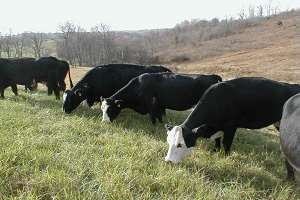By Chris Penrose
If you have stockpiled forages like orchardgrass and fescue, sometimes the question of when and how should we feed it to our cattle comes up? There are many variables, but let’s start with a few basic principles. The earlier you initiated stockpiling, the more yield you will have, but the lower the quality will be. Conversely, the later in the year you start to stockpile, the lower the yield will be and the higher the quality (Table 1). When you add ~50# of nitrogen per acre, crude protein should rise (Table 2) and yields can increase up to a ton per acre.
Table 1. Effect of final clipping date on dry matter yield and crude protein (CP) concentration in stockpiled tall fescue forage in Southeast Ohio (source: Maximizing Fall and Winter Grazing for Beef and Stocker Cattle, OSU Extension bulletin 472).
Final Clipping
Date | Yield (lbs/acre)
on Nov 3 | ————- % CP ———— |
| | | Nov. 3 | Dec 20 | Feb 11 |
| July 1, 1990 | 3761 | 13.9 | 10.1 | 9.6 |
| Aug. 16, 1990 | 3194 | 15.2 | 11.0 | 10.9 |
Table 2. Effect of nitrogen application date on crude protein (CP) and acid detergent fiber (ADF) concentrations in stockpiled tall fescue forage in Southeast Ohio (OSU Extension bulletin 472).
| Application Date | ——– % CP ——– | ——– % ADF ——- |
| | Nov 3 | Dec 20 | Feb 11 | Nov 3 | Dec 20 | Feb 11 |
| Aug. 20, 1990 | 14.4 | 10.9 | 10.2 | 33.1 | 36.5 | 40.3 |
| Sept. 24, 1990 | 17.3 | 11.3 | 11.8 | 30.0 | 34.6 | 38.9 |
Table 1. Effect of final clipping date on dry matter yield and crude protein (CP) concentration in stockpiled tall fescue forage in Southeast Ohio (source: Maximizing Fall and Winter Grazing for Beef and Stocker Cattle, OSU Extension bulletin 472).
Replicated trials we’ve done over the past three years have further confirmed these principles.
Another principle is that as the winter progresses orchardgrass quality and quantity will decrease before fescue. Typically, I recommend feeding orchardgrass before the end of the year followed by fescue. Some producers can then make it through most of the balance of winter on stockpiled fescue, if weather conditions permit.

If you have stockpiled fescue, you have options. First, know where you’re at. My co-worker, Ed Brown, ANR Educator in Athens County had an article in the Farm and Dairy (11/16/2016) and suggested that we need to test our fescue (keeping in mind that fescue quality will decrease over time) and our hay so we can balance our quality of our forages to the needs of our cattle. I could not agree more. For example, if our fescue quality is at 12% protein and we have mid gestation cows in good condition, we could limit access to the fescue and supplement with some lower quality hay to stretch out the fescue.
Stockpiled fescue is best utilized by strip grazing. The best way I have seen is when the farmer gives a long stretch of fescue several feet deep which acts like a long feed bunk to maximize utilization. Several will also place hay in the field at strategic locations when the ground is firm and move electric fence as needed, allowing the cows to have both hay and stockpiled fescue. This also reduces mud damage to fields.
There are also other times I feed stockpiled fescue. In November my son and I took a short trip and we did not have anyone to feed the cows so we put our cattle on a piece of stockpiled fescue while we were away. The other way I love to feed stockpiled fescue is to my spring calving herd just at calving time in the beginning of March. I turn the cows into a stockpiled, thick sod, “clean field” to calve in, where there are no mud problems and I do not need to feed any more hay. I even notice they pick up a little on condition. However, I do supplement a couple pounds of corn a day to them.
Probably the best thing I love about feeding stockpiled forages is the time saved. Reducing the amount of time we feed stored forages not only saves time, but wear and tear on equipment and the need for as much stored feed.
Source: osu.edu